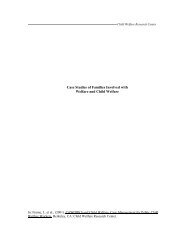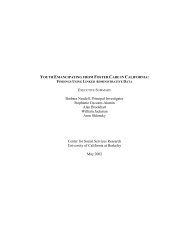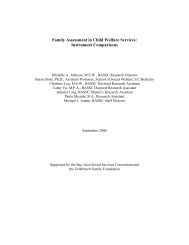areas <strong>of</strong> MCOs and contains information on health plan type, pr<strong>of</strong>it status, membership size, andmodel type. Organizational characteristics <strong>of</strong> the universe <strong>of</strong> MCOs are provided in Exhibit 1.Exhibit 1ORGANIZATIONAL STRUCTURE OF MCOS IN THEAAHP 2001 DIRECTORY OF HEALTH PLANSUnavailable2% (n=16)Health Plan TypeHMO29% (n = 263)Mix45% (n=403)PPO23% (n = 210)POS1% (n=12)IPA31% (n = 280)Model TypeNetwork15%(n = 133)Unavailable18% (n=14)Group8% (n=6)Group4% (n=36)Staff2% (n=12)Mix7% (n=68)Pr<strong>of</strong>it StatusNon -pr<strong>of</strong>itFor Pr<strong>of</strong>it32% (n =293)68% (n =611)Membership Size*Small Large32% (n = 290) 25% (n = 232)Medium38% (n=340)Unavailable5% (n=42)* • Smalall = 500-49,999• Medium = 50,000000 -199,999• Lararge = 200,000+Disadvantages associated with using an association’s directory as a study sampling frameare shared by any similar directory. First, directory listings typically have a lag <strong>of</strong> about a yearbetween information collection and publication, which could be especially problematic for thisstudy considering the level <strong>of</strong> consolidation occurring in the health care system at that time.Second, because directories <strong>of</strong>ten serve as a sort <strong>of</strong> yellow pages where purchasers can seek outorganizations in certain geographic locales, listings are <strong>of</strong>ten too detailed and repetitious. Suchrepetition may require a fair amount <strong>of</strong> file manipulation to remove duplicate listings, at somecost.During the study design phase, several characteristics and conditions were explored andconsidered for developing an appropriate sampling strategy. The most important component wasto ensure that the study sample would reflect a nationally representative group <strong>of</strong> MCOs. Asecond consideration was that the MCOs selected for study participation should includeorganizational, membership, and geographic variation.Discussions were held among the research team, OMH staff, and the project advisorygroups to determine the appropriate strategy. Initially, the research team proposed severalvariables for stratifying the sample <strong>of</strong> MCOs, including the metropolitan statistical areas (MSAs)in which the organizations reside; organizational characteristics such as health plan type,pr<strong>of</strong>it/non-pr<strong>of</strong>it status, or membership size <strong>of</strong> each MCO; and demographic characteristics (e.g.,racial, ethnic, cultural, and linguistic composition) <strong>of</strong> the population served by each MCO.Following extensive deliberations, members <strong>of</strong> the expert panel advised that the rapidlychanginglandscape <strong>of</strong> health plans—at both the service and organizational levels—was tooCOSMOS Corporation, December 2003 G-3
complex and uncertain at the time to employ a stratified sampling strategy <strong>of</strong> any sort. Becausethe health care system was in a fluid and evolutionary state, many MCOs were merging withother organizations, and many were going out <strong>of</strong> business. As such, characteristics or conditionsthat would normally be used to stratify a sample <strong>of</strong> MCOs were transient during the time <strong>of</strong> thisstudy. Therefore, the group concluded that the most appropriate strategy for selecting the studysample was the most parsimonious one, i.e., a national random selection <strong>of</strong> MCOs.To ensure that the sample drawn would be representative <strong>of</strong> all MCOs, calculations wereperformed to determine the degree <strong>of</strong> precision with which generalizations could be made to thetarget national population. The most typical measure <strong>of</strong> survey precision is the widths <strong>of</strong>confidence intervals for simple univariate estimates and for estimates within analyticalsubgroups. An analysis <strong>of</strong> confidence intervals for this study revealed that a sample <strong>of</strong> 240MCOs (from the universe <strong>of</strong> approximately 1,100 at the time) would allow 95 percentconfidence intervals for categorical variables that have widths <strong>of</strong> approximately 4-7 percent. Fortypical subgroup analyses utilizing six subgroups, a sample <strong>of</strong> 240 MCOs would yieldconfidence intervals that range in width from 6-15 percent, depending on the size <strong>of</strong> thesubgroup sample and the particular variable.2. DEVELOPING THE DATA COLLECTION PLANOnce the three respondent types (per MCO) were identified, the next step was to develop adata collection plan which would most likely render a high response rate. Here too, however, therapidly-changing structure <strong>of</strong> MCOs at the time—i.e., the evolution <strong>of</strong> the organizationsthemselves, as well as changes in the staff within the organizations—influenced the decisionsmade during the data collection planning phase.The first point <strong>of</strong> contact with each MCO would be an introductory letter mailed to theorganization’s senior executive, as listed in the AAHP directory, with a follow-up telephone callconducted to confirm receipt <strong>of</strong> the letter and determine the senior executive’s availability forstudy participation. The contact information in the directory provided a starting point forpenetrating the MCOs and for determining the appropriate senior executive to complete thetelephone interview.An interview is the most appropriate method for gathering information on an organization’spolicies, histories, and future plans; because the types <strong>of</strong> information to be collected typicallyrequire the participation <strong>of</strong> senior-level executives who have busy schedules, these respondentsare more likely to agree to a telephone interview than to a face-to-face interview (Marshall andRossman 2000). The telephone interviews for this study would be conducted using ComputerAssisted Telephone Interviewing (CATI) by experienced interviewers who would receivetraining specifically for this data collection effort. The use <strong>of</strong> CATI provides a number <strong>of</strong> timesavingadvantages in the data collection process including: electronic recording <strong>of</strong> aparticipant’s responses (eliminating the manual data entry step); electronic guidance through theinterview (e.g., making appropriate skips automatically based on the respondent’s answers); andlogic checking capability to ensure consistent responses.COSMOS Corporation, December 2003 G-4
- Page 1 and 2:
Developing a Self-Assessment Toolfo
- Page 3 and 4:
ContentsChaptersPage1. Introduction
- Page 5 and 6:
Chapter 1Introduction
- Page 7 and 8:
While many LPHAs currently provide
- Page 9 and 10:
LPHAs include: adult and child immu
- Page 11 and 12:
Professions Education Partnership A
- Page 13 and 14:
Chapter 2Methodology for Developing
- Page 15 and 16:
Public Health Practice Program Offi
- Page 17 and 18:
assess their own beliefs and have k
- Page 19 and 20:
communicate with, and clearly under
- Page 21 and 22:
2.1.6 Identifying Key Components of
- Page 23 and 24:
Given these persistent disparities
- Page 25 and 26:
(Exhibit 2-2, Continued)DOMAIN / KE
- Page 27 and 28:
limited to the actual clinical enco
- Page 29 and 30:
Chapter 3Project Results and Recomm
- Page 31 and 32:
local board of health. PEP and PAG
- Page 33 and 34:
numerous promising CLAS practices a
- Page 35 and 36:
References
- Page 37 and 38:
Becker, M.H., and L.A. Maiman, “S
- Page 39 and 40:
Frye, B., “Health Care Decision M
- Page 41 and 42:
Marin, G., “Defining Culturally A
- Page 43 and 44:
Perkins, Jane, “Overcoming Langua
- Page 45 and 46:
U.S. Bureau of the Census, “Censu
- Page 47 and 48:
Appendix AMembership Lists of the P
- Page 49 and 50:
Appendix A-1Developing a Self-Asses
- Page 51 and 52:
Appendix A-2Developing a Self-Asses
- Page 53 and 54:
Appendix B-1Overview of Eight CLAS
- Page 55 and 56:
Domain 3: Culturally Inclusive Heal
- Page 57 and 58:
understanding of diversity issues i
- Page 59 and 60:
Appendix B-2Conceptual Framework fo
- Page 61 and 62:
Appendix CLPHA Director or Designee
- Page 63 and 64: Pre-Interview Script for LPHA Direc
- Page 65 and 66: 3b. Which of the following are refl
- Page 67 and 68: 6. Does your agency have a formal p
- Page 69 and 70: 10. Which of the following describe
- Page 71 and 72: Post-Interview Script for LPHA Dire
- Page 73 and 74: Appendix DStaffing Questionnaire
- Page 75 and 76: A. QUALITY MONITORING AND IMPROVEME
- Page 77 and 78: B. MANAGEMENT INFORMATION SYSTEMS (
- Page 79 and 80: 7. Please indicate, if you know, th
- Page 81 and 82: 1c. Please indicate for which categ
- Page 83 and 84: 6. Please indicate for which catego
- Page 85 and 86: 10. Which of the following topical
- Page 87 and 88: 17. Which of the following benefits
- Page 89 and 90: 4. Which of the following strategie
- Page 91 and 92: Appendix EClient Services Questionn
- Page 93 and 94: A. QUALITY MONITORING AND IMPROVEME
- Page 95 and 96: 6b.Which of the following community
- Page 97 and 98: 3. Please report or estimate what p
- Page 99 and 100: 3. Which of the following practices
- Page 101 and 102: Oral Interpretation Services10. Whi
- Page 103 and 104: 16. At which of the following key e
- Page 105 and 106: 3. Which of the following kinds of
- Page 107 and 108: Appendix FPilot Test Response Form
- Page 109 and 110: RESPONDENT EVALUATIONOF THE QUESTIO
- Page 111 and 112: Appendix GCLAS in MCOs Study Data C
- Page 113: position, as titles will likely var
- Page 117 and 118: 1. Incorporate a confirmation pre-c
- Page 119 and 120: Exhibit 2DATA COLLECTION PROCESSSen
















